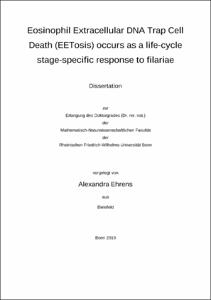Eosinophil Extracellular DNA Trap Cell Death (EETosis) occurs as a life-cycle stage-specific response to filariae

Eosinophil Extracellular DNA Trap Cell Death (EETosis) occurs as a life-cycle stage-specific response to filariae

| dc.contributor.advisor | Hoerauf, Achim | |
| dc.contributor.advisor | ||
| dc.contributor.author | Ehrens, Alexandra | |
| dc.date.accessioned | 2020-06-25T10:42:55Z | |
| dc.date.available | 2021-07-01T22:00:19Z | |
| dc.date.issued | 25.06.2020 | |
| dc.identifier.uri | https://hdl.handle.net/20.500.11811/8424 | |
| dc.description.abstract | Filarial nematodes represent a great burden of human morbidity causing diseases like onchocerciasis and lymphatic filariasis. The lack of a vaccination and a short-term therapy with a macrofilaricidal effect hampers the elimination of filarial diseases. To successfully eliminate filariasis, not only new therapies, but also a detailed knowledge of protective immunity is needed. Helminths typically induce a type 2 immune response in their host with a profound eosinophilia. Eosinophils are a pivotal cell type in controlling helminth infections and are of particular importance in eliminating microfilariae (MF), the progeny of the filariae. Next to the release of cytotoxic granules, a newly recognized defense mechanism of granulocytes is the so called extracellular DNA trap cell death (ETosis), which results in the release of intracellular DNA into the surrounding. The results show for the first time that bone marrow-derived eosinophils as well as eosinophils isolated from infected animals are able to produce eosinophil extracellular DNA traps (EETs) of nuclear and primarily of mitochondrial origin in response to Litomosoides sigmodontis MF and inhibit MF motility in a DNA-trap- and cell contact-dependent manner in vitro. MF-induced ETosis was not based on shear forces, independent on antibody-coating and required no prior priming. Within this thesis the dectin-1 receptor was identified as the underlying receptor in MF-induced ETosis. Results from this thesis further suggest the DNA-dependent inhibition of MF motility and MF-induced DNA release by eosinophils as a conserved mechanism, since murine eosinophils responded to MF derived from the rodent filarial nematode L. sigmodontis and the canine heartworm Dirofilaria immitis. In vivo results showed an increase in local DNA concentration upon L. sigmodontis infection and raised systemic DNA concentrations upon intravenous MF injection, which was partly mediated by eosinophils, indicating a potential role of EETosis in vivo as well. Furthermore, several pre-clinical studies using the L. sigmodontis rodent model were conducted identifying new macrofilaricidal drug candidates against human filariasis. In conclusion, the results of this thesis show for the first time that murine EETosis occurs in response to filariae and identifies the dectin-1 receptor-recognition being responsible for the MF-induced ETosis. Furthermore, the results contribute to the knowledge about eosinophil-mediated protective immunity and show that EETosis occurs as a universal and conserved mechanism against a variety of pathogens. Finally, new potential drug candidates were tested, which present promising candidates for the elimination of human filariasis. | en |
| dc.language.iso | eng | |
| dc.rights | In Copyright | |
| dc.rights.uri | http://rightsstatements.org/vocab/InC/1.0/ | |
| dc.subject | Eosinophils | |
| dc.subject | granulocytes | |
| dc.subject | filariae | |
| dc.subject | Litomosoides sigmodontis | |
| dc.subject | microfilariae | |
| dc.subject | extracellular DNA traps | |
| dc.subject | ETosis | |
| dc.subject | dectin-1 | |
| dc.subject | Dirofilaria immitis | |
| dc.subject | protective immunity against filariae | |
| dc.subject | macrofilaricidal drug candidates | |
| dc.subject | onchocerciasis | |
| dc.subject | lymphatic filariasis | |
| dc.subject.ddc | 570 Biowissenschaften, Biologie | |
| dc.subject.ddc | 610 Medizin, Gesundheit | |
| dc.title | Eosinophil Extracellular DNA Trap Cell Death (EETosis) occurs as a life-cycle stage-specific response to filariae | |
| dc.type | Dissertation oder Habilitation | |
| dc.publisher.name | Universitäts- und Landesbibliothek Bonn | |
| dc.publisher.location | Bonn | |
| dc.rights.accessRights | openAccess | |
| dc.identifier.urn | https://nbn-resolving.org/urn:nbn:de:hbz:5-58496 | |
| ulbbn.pubtype | Erstveröffentlichung | |
| ulbbnediss.affiliation.name | Rheinische Friedrich-Wilhelms-Universität Bonn | |
| ulbbnediss.affiliation.location | Bonn | |
| ulbbnediss.thesis.level | Dissertation | |
| ulbbnediss.dissID | 5849 | |
| ulbbnediss.date.accepted | 24.04.2020 | |
| ulbbnediss.institute | Medizinische Fakultät / Institute : Institut für Medizinische Mikrobiologie, Immunologie und Parasitologie (IMMIP) | |
| ulbbnediss.fakultaet | Mathematisch-Naturwissenschaftliche Fakultät | |
| dc.contributor.coReferee | Förster, Irmgard | |
| ulbbnediss.contributor.orcid | https://orcid.org/0000-0002-2570-4034 | |
| ulbbnediss.date.embargoEndDate | 01.07.2021 | |
| ulbbnediss.contributor.gnd | 123894163X |
Files in this item
This item appears in the following Collection(s)
-
E-Dissertationen (4378)




